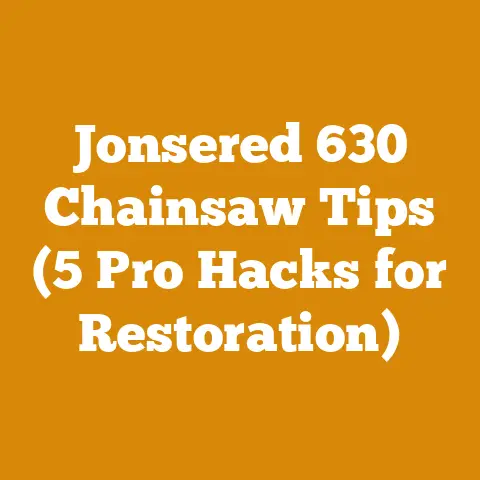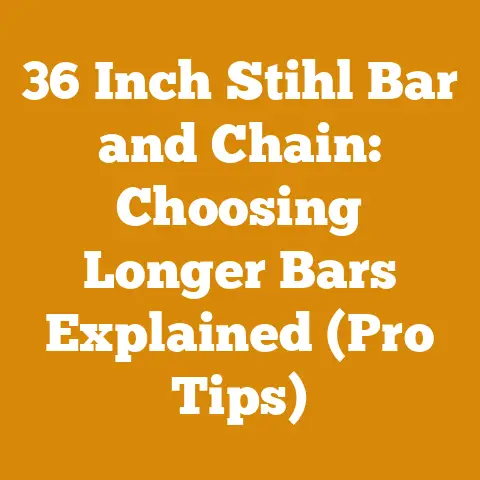How to Kill a Tree Stump Using Epsom Salt (5 Proven Arborist Tips)
Do you ever stand in your yard, staring at a stubborn tree stump, feeling a mix of frustration and defeat?
I know I have.
It’s like a permanent reminder of a tree long gone, an obstacle to your landscaping dreams, and a potential hazard lurking just beneath the surface.
Removing a tree stump can be a back-breaking task, often involving heavy machinery or expensive professional services.
But what if I told you there’s a simpler, more environmentally friendly way to tackle this problem?
A method that utilizes a common household ingredient: Epsom salt.
Over the years, I’ve dealt with countless tree stumps, both in my personal life and in my work with wood processing and firewood preparation.
I’ve tried various methods, from digging them out manually (a nightmare, trust me!) to using chemical stump removers.
While some methods work faster, they often come with drawbacks like soil contamination or requiring specialized equipment.
That’s why I’ve become a big advocate for using Epsom salt.
It’s a slower process, but it’s safe, effective, and doesn’t involve harsh chemicals.
In this guide, I’ll share my tried-and-true method for killing tree stumps using Epsom salt, along with five proven arborist tips to maximize your success.
I’ll break down each step, explain the science behind it, and offer practical advice based on my experience.
Whether you’re a seasoned woodworker, a weekend DIYer, or simply someone looking to reclaim their yard, this guide will provide you with the knowledge and confidence to tackle those pesky tree stumps once and for all.
How to Kill a Tree Stump Using Epsom Salt (5 Proven Arborist Tips)
1. Understanding the Science Behind Epsom Salt and Stump Removal
Before diving into the how-to, let’s understand why Epsom salt works.
Epsom salt, chemically known as magnesium sulfate (MgSO₄), is a naturally occurring mineral compound.
It’s widely used in gardening and agriculture as a soil amendment, providing plants with essential magnesium and sulfur.
However, in high concentrations, Epsom salt can be detrimental to plant life, including tree stumps.
The high concentration of salt draws moisture out of the wood, essentially dehydrating the stump.
This dehydration process inhibits the growth of fungi and bacteria that naturally decompose wood, effectively halting the stump’s ability to regenerate or sprout new shoots.
Furthermore, the salt creates an unfavorable environment for the remaining living cells within the stump, eventually leading to its death and accelerated decomposition.
Key Concepts:
- Osmosis: The movement of water across a semipermeable membrane from an area of high concentration to an area of low concentration.
The high salt concentration outside the stump draws water out, disrupting its internal processes. - Decomposition: The natural process of breaking down organic matter.
Epsom salt inhibits this process in the short term by creating an inhospitable environment for decomposers. - Magnesium and Sulfur: Essential nutrients for plants in low concentrations.
However, in high doses, they can become toxic.
2. Gathering Your Supplies: The Right Tools for the Job
Having the right tools and materials is crucial for a successful stump removal project.
Here’s a list of what you’ll need:
- Epsom Salt: The star of the show!
Purchase Epsom salt in bulk for the best value.
I typically use a 5-10 pound bag, depending on the size of the stump. - Drill: A standard power drill with a long drill bit (at least 12 inches) is essential for creating deep holes in the stump.
A ½-inch or ¾-inch drill bit is ideal. - Water: Used to dissolve the Epsom salt and saturate the stump.
- Measuring Cup or Container: For accurately measuring the Epsom salt and water.
- Funnel (Optional): Makes it easier to pour the Epsom salt solution into the drilled holes.
- Tarp or Plastic Sheeting: To cover the stump after treatment and protect it from rain.
- Heavy Object (Rock, Brick, etc.): To weigh down the tarp and secure it in place.
- Safety Glasses: Protect your eyes from flying wood chips during drilling.
- Gloves: To protect your hands from splinters and the Epsom salt solution.
- Chainsaw (Optional): If the stump is particularly tall, you may want to use a chainsaw to cut it down closer to ground level before starting the treatment.
- Axe (Optional): For removing loose bark or creating a flat surface for drilling.
Tool Specifications:
- Drill Bit: I recommend a high-speed steel (HSS) drill bit with a diameter of ½ inch to ¾ inch.
The length should be at least 12 inches to create sufficiently deep holes. - Chainsaw (Optional): If using a chainsaw, ensure it’s properly sharpened and equipped with appropriate safety features.
A 16-inch bar is typically sufficient for most stump-cutting tasks.
I personally use a Stihl MS 271 Farm Boss for larger stumps, but a smaller electric chainsaw works well for smaller projects. - Axe (Optional): A standard splitting axe or a smaller hatchet can be used for bark removal and surface preparation.
3. Step-by-Step Guide: Killing the Stump with Epsom Salt
Now, let’s get down to the actual process of killing the tree stump.
Follow these steps carefully for the best results.
Step 1: Prepare the Stump
- Cut the Stump Low: If the stump is tall, use a chainsaw to cut it down as close to ground level as possible.
This will make the treatment more effective and less noticeable.
Aim for a height of 4-6 inches above the ground. - Clean the Surface: Remove any loose bark, dirt, or debris from the top of the stump using an axe or a stiff brush.
This will ensure that the Epsom salt solution can penetrate the wood effectively.
Step 2: Drill the Holes
- Drill Pattern: Using your drill, create a series of holes in the top of the stump.
The number and pattern of holes will depend on the size of the stump.
For a stump with a diameter of 12 inches or less, drill at least 6-8 holes.
For larger stumps, increase the number of holes accordingly. - Hole Depth and Diameter: Drill the holes as deep as possible, ideally reaching down to the roots.
Aim for a depth of at least 8-10 inches.
The diameter of the holes should be ½ inch to ¾ inch. - Spacing: Space the holes evenly across the surface of the stump, leaving about 2-3 inches between each hole.
You can also drill holes around the perimeter of the stump to target the cambium layer, which is responsible for growth. - Angled Holes (Optional): For added effectiveness, consider drilling some holes at an angle, pointing towards the center of the stump.
This will help the Epsom salt solution reach more of the wood.
Step 3: Apply the Epsom Salt Solution
- Mix the Solution: In a container, mix Epsom salt with hot water to create a saturated solution.
The ratio should be approximately 1 part Epsom salt to 1 part water.
Stir the mixture until the salt is completely dissolved.
You’ll know it’s saturated when no more salt will dissolve. - Pour the Solution: Using a funnel (optional), carefully pour the Epsom salt solution into each of the drilled holes.
Fill the holes completely, allowing the solution to soak into the wood. - Repeat as Necessary: As the solution soaks into the wood, refill the holes as needed.
Continue this process until the stump is thoroughly saturated.
Step 4: Cover and Protect the Stump
- Cover the Stump: Cover the treated stump with a tarp or plastic sheeting.
This will help to prevent rain from diluting the Epsom salt solution and keep animals from disturbing the stump. - Secure the Tarp: Weigh down the tarp with a heavy object, such as a rock or a brick, to keep it in place.
Step 5: Wait and Repeat
- Patience is Key: The Epsom salt treatment takes time to work.
It may take several weeks or even months for the stump to completely die and begin to decompose. - Reapply Regularly: Check the stump periodically and reapply the Epsom salt solution as needed, especially after heavy rain.
The more consistently you keep the stump saturated with the solution, the faster it will decompose. - Monitor for Growth: Keep an eye out for any new sprouts or shoots emerging from the stump.
If you see any signs of life, reapply the Epsom salt solution immediately.
Case Study:
I once had a particularly stubborn oak stump in my backyard that I couldn’t get rid of.
I tried digging it out, but the roots were too extensive.
I decided to try the Epsom salt method.
I followed the steps outlined above, drilling numerous holes and saturating the stump with the solution.
I covered it with a tarp and patiently waited.
After about three months, I noticed that the stump was starting to soften and crumble.
Over the next year, it gradually decomposed, and I was eventually able to easily remove the remaining pieces.
4. Five Proven Arborist Tips for Maximizing Success
Here are five additional tips from my experience as an arborist to help you achieve the best possible results with Epsom salt stump removal:
Tip 1: Time of Year Matters:
- Best Time: The best time to treat a tree stump with Epsom salt is during the fall or winter months.
This is because trees are generally less active during these periods, and the Epsom salt solution will be more effective at penetrating the wood and disrupting its internal processes. - Avoid Spring: Avoid treating stumps in the spring, as this is when trees are actively growing and may be more resistant to the treatment.
Tip 2: Enhance Penetration with Copper Nails:
- Copper’s Role: Copper is a natural biocide and can help to accelerate the decomposition process.
- How to Use: After drilling the holes, insert several copper nails or small pieces of copper wire into the holes before adding the Epsom salt solution.
This will further enhance the effectiveness of the treatment.
I’ve found that using roofing nails made of copper works best.
Tip 3: Combine Epsom Salt with Other Methods:
- Layered Approach: For particularly stubborn stumps, consider combining the Epsom salt treatment with other methods, such as applying a nitrogen-rich fertilizer to the surrounding soil.
This will help to stimulate the growth of decomposer organisms, which will further accelerate the breakdown of the stump. - Burning (With Caution): Once the stump is thoroughly dried out and decomposed, you can consider burning it (where permitted and safe to do so).
This will help to remove the remaining debris and clear the area for landscaping.
However, exercise extreme caution when burning, and always follow local regulations and safety guidelines.
Tip 4: Consider Stump Grinding (After Treatment):
- Stump Grinding: After the Epsom salt treatment has weakened the stump, consider using a stump grinder to remove the remaining portion.
This will make the removal process much easier and faster. - Rental Options: Stump grinders can be rented from most equipment rental companies.
Be sure to follow the manufacturer’s instructions carefully and wear appropriate safety gear, including eye and ear protection.
Tip 5: Promote Natural Decomposition:
- Encourage Decomposers: Once the stump is treated, create a favorable environment for decomposer organisms by adding organic matter to the surrounding soil, such as compost, wood chips, or leaf litter.
- Maintain Moisture: Keep the soil around the stump moist to encourage the growth of fungi and bacteria that will help to break down the wood.
5. Safety Considerations: Protecting Yourself and the Environment
While Epsom salt is a relatively safe and environmentally friendly option for stump removal, it’s still important to take certain safety precautions:
- Eye Protection: Always wear safety glasses when drilling or cutting wood to protect your eyes from flying debris.
- Hand Protection: Wear gloves to protect your hands from splinters and the Epsom salt solution.
- Respiratory Protection: If you’re using a chainsaw or stump grinder, wear a dust mask or respirator to protect your lungs from wood dust.
- Environmental Considerations: Avoid applying Epsom salt near sensitive plants or water sources, as it can harm them.
- Proper Disposal: Dispose of any leftover Epsom salt solution properly.
Do not pour it down the drain or into waterways.
Specific Safety Measures:
- Chainsaw Safety: If using a chainsaw, always wear appropriate personal protective equipment (PPE), including a helmet, eye protection, hearing protection, gloves, and chainsaw chaps.
Be sure to follow the manufacturer’s instructions carefully and never operate a chainsaw while fatigued or under the influence of drugs or alcohol. - Stump Grinder Safety: If using a stump grinder, wear appropriate PPE, including eye protection, hearing protection, and heavy-duty gloves.
Be sure to clear the area of any rocks or debris before operating the grinder, and never allow anyone to stand in the path of the grinding wheel.
Bonus: Alternative Methods and Considerations
While Epsom salt is a great option, it’s not the only way to deal with tree stumps.
Here are some alternative methods and considerations:
- Manual Removal: Digging out the stump by hand is a labor-intensive option, but it can be effective for smaller stumps.
- Chemical Stump Removers: Chemical stump removers contain strong chemicals that accelerate the decomposition process.
However, they can be harmful to the environment and should be used with caution. - Hire a Professional: If you’re not comfortable tackling the stump removal yourself, you can always hire a professional arborist or landscaping company.
- Embrace the Stump: Consider incorporating the stump into your landscaping design.
You can turn it into a planter, a bird bath, or a decorative feature.
Green Wood vs. Seasoned Wood:
- Green Wood: Freshly cut wood that has a high moisture content (typically above 30%).
Green wood is more difficult to split and burn than seasoned wood. - Seasoned Wood: Wood that has been allowed to dry for a period of time (typically 6-12 months).
Seasoned wood has a lower moisture content (typically below 20%) and burns more efficiently.
The Epsom salt method works best on green wood, as it’s more absorbent.
Strategic Advantages of Using Epsom Salt:
- Cost-Effective: Epsom salt is a relatively inexpensive option for stump removal.
- Environmentally Friendly: It’s a safer alternative to chemical stump removers.
- Easy to Use: The process is simple and straightforward.
- No Heavy Machinery Required: You don’t need to rent or purchase expensive equipment.
Estimated Costs and Timing:
- Epsom Salt: $10-$20 per bag (5-10 pounds)
- Drill Bit: $10-$30
- Time: Several weeks to several months, depending on the size and type of stump.
Conclusion: Reclaim Your Yard and Enjoy the Results
Killing a tree stump with Epsom salt requires patience and persistence, but the results are well worth the effort.
By following the steps outlined in this guide and incorporating the five proven arborist tips, you can effectively eliminate those unsightly stumps and reclaim your yard for landscaping, gardening, or simply enjoying the outdoors.
Remember to prioritize safety and consider the environmental impact of your actions.
Now that you have the knowledge and tools, it’s time to get started.
Choose a stubborn stump in your yard and put these techniques into practice.
I am confident that you will find this method to be a safe, effective, and environmentally friendly way to deal with unwanted tree stumps.
Happy stump removing!






